Lady Angelika |
|||||||||||||||||||
 |
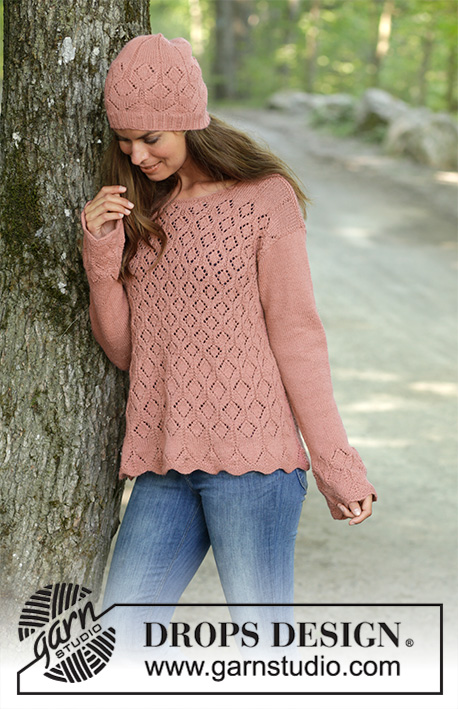 |
||||||||||||||||||
Knitted jumper with lace pattern in DROPS Flora. Sizes S - XXXL. Knitted hat with lace pattern in DROPS Flora.
DROPS 197-24 |
|||||||||||||||||||
|
EXPLANATIONS FOR THE PATTERN: ------------------------------------------------------- RIDGE/GARTER STITCH (worked in the round): 1 ridge = 2 rounds. Knit 1 round and purl 1 round. PATTERN: Jumper: See diagrams A.1 to A.7. Choose diagram for your size (applies to A.5 and A.6). Hat: See diagrams A.3, A.8 and A.9. The diagrams show all the rows in the pattern seen from the right side. INCREASE TIP (for mid under sleeve): Start 1 stitch before the stitch with the marker thread, make 1 yarn over, knit 3 (the marker thread sits in the middle stitch of these 3 stitches), make 1 yarn over (= 2 stitches increased). On the next round knit the yarn overs twisted to avoid holes. DECREASE TIP-1 (evenly spaced): To work out how to decrease evenly, count the total number of stitches on the needle (e.g. 124 stitches) and divide by the number of decreases to be made (e.g. 16) = 7.75. In this example, decrease by knitting each 7th and 8th stitch together (approx.). DECREASE TIP-2 (for top of hat): Decrease as follows before the garter stitch: Start 2 stitches before the stitch with the marker thread, knit 2 together (= 1 stitch decreased). Decrease as follows after the garter stitch: Slip 1 stitch as if to knit, knit 1 and pass the slipped stitch over the knitted stitch (= 1 stitch decreased). ---------------------------------------------------------- START THE PIECE HERE: ------------------------------------------------------- JUMPER – SHORT OVERVIEW OF THE PIECE: The piece is worked in the round with circular needle, bottom up as far as the armholes. Then the front and back pieces are worked separately, back and forth with circular needle. The sleeves are worked in the round with double pointed needles/short circular needle, bottom up. BODY: Cast on 280-308-336-364-420-448 slightly loose stitches with circular needle size 3.5 mm and Flora. Work 3 RIDGES in the round – read description above. Work 2 rounds of stocking stitch. Then work A.1 in the round (= 20-22-24-26-30-32 repeats of 14 stitches). When A.1 has been completed there are 240-264-288-312-360-384 stitches on the needle and the piece measures approx. 7 cm from the cast-on edge at the longest point. REMEMBER THE KNITTING TENSION! Then work A.2 (= 20-22-24-26-30-32 repeats of 12 stitches). When A.2 has been completed, work A.3 (= 20-22-24-26-30-32 repeats of 12 stitches). When A.3 has been completed there are 200-220-240-260-300-320 stitches on the needle. Then work A.4 (= 20-22-24-26-30-32 repeats of 10 stitches). When A.4 has been worked a total of 3 times in height, insert 2 marker threads in the piece as follows (without working the stitches): The first marker thread is inserted in the first stitch on the round, then count 99-109-119-129-149-159 stitches and insert 1 marker thread in the next stitch. There are 99-109-119-129-149-159 stitches left on the round after the second marker thread. The threads mark the sides of the body. READ THE REST OF BODY BEFORE CONTINUING! PATTERN: The next round is worked as follows: Work 5-10-15-15-25-30 stitches in stocking stitch (marker thread in first of these stitches), work A.5A (= 5 stitches), A.5B over the next 80-80-80-90-90-90 stitches (= 8-8-8-9-9-9 repeats of 10 stitches), A.5C (= 6 stitches), work 9-19-29-29-49-59 stitches in stocking stitch (marker thread in the middle stitch of these stitches), work A.5A (= 5 stitches), A.5B over the next 80-80-80-90-90-90 stitches (= 8-8-8-9-9-9 repeats of 10 stitches), A.5C (= 6 stitches) and finish with 4-9-14-14-24-29 stitches in stocking stitch. Continue this pattern, but when A.5 has been worked 1-1-1-2-2-2 times in height work A.6 over A.5 in the same way. When A.X in A.6 has been worked 1 time in height work A.Y to finished length. ARMHOLE: AT THE SAME TIME when the piece measures 38-38-39-40-41-42 cm cast off for armholes in each side as described below. The marker threads have been inserted in the piece and you should have started A.5 as described above, but adjust so that the next round is an odd round in the diagrams, i.e. a round of lace pattern. This is important so that the rows of pattern are worked from the right side when you start working back and forth. The cast-off round is worked as follows: Cast off 3-3-4-4-6-8 stitches for armhole, work the next 95-105-113-123-139-145 stitches as before, cast off 5-5-7-7-11-15 stitches for armhole, work the next 95-105-113-123-139-145 stitches as before and cast off the remaining 2-2-3-3-5-7 stitches for armhole. Front and back pieces are finished separately. FRONT PIECE: = 95-105-113-123-139-145 stitches. Continue the pattern back and forth as before (the first row is from the wrong side and each row from the wrong side is purled). AT THE SAME TIME cast off for armholes at the beginning of each row in each side as follows: Cast off 3 stitches 0-0-0-0-2-3 times, 2 stitches 0-2-3-3-4-4 times and then 1 stitch 1-2-4-4-4-4 times in each side = 93-93-93-103-103-103 stitches left. Continue the pattern as before with 1 edge stitch in each side (knit edge stitch from right and wrong side). When the piece measures approx. 48-50-52-53-55-57 cm (A.X in A.6 should now be finished and A.Y should have started) place the middle 19-19-19-23-23-23 stitches on 1 thread for neck and each shoulder is finished separately. Continue casting off for neck at the beginning of each row from the neck as follows: Cast off 2 stitches 3 times and 1 stitch 3 times = 28-28-28-31-31-31 stitches left on shoulder. Continue working until there is 1 row left before the piece measures 56-58-60-62-64-66 cm. Knit 1 row from the wrong side. Loosely cast off with knit from the right side. Work the other shoulder in the same way. BACK PIECE: = 95-105-113-123-139-145 stitches. Continue the pattern back and forth as before (the first row is from the wrong side and each row from the wrong side is purled). AT THE SAME TIME cast off for armholes at the beginning of each row in each side as follows: Cast off 3 stitches 0-0-0-0-2-3 times, 2 stitches 0-2-3-3-4-4 times and then 1 stitch 1-2-4-4-4-4 times in each side = 93-93-93-103-103-103 stitches left. Continue the pattern as before with 1 edge stitch in each side (knit edge stitch from right and wrong side). Remember that when A.X in A.6 has been worked 1 time in height, you continue with A.Y to finished length. AT THE SAME TIME when the piece measures 54-56-58-60-62-64 cm cast off the middle 33-33-33-37-37-37 stitches for neck and each shoulder is finished separately. Then cast off 2 stitches on the next row from the neck = 28-28-28-31-31-31 stitches left on shoulder. Continue working until there is 1 row left before the piece measures 56-58-60-62-64-66 cm. Knit 1 row from the wrong side. Loosely cast off with knit from the right side. Work the other shoulder in the same way. SLEEVE: Cast on 60-60-60-72-72-72 slightly loose stitches with double pointed needles size 3.5 mm and Flora. Work 3 ridges in the round. Work 2 rounds of stocking stitch. Then work A.7 in the round (= 5-5-5-6-6-6 repeats of 12 stitches). When A.7 has been completed work A.3 in the round (= 5-5-5-6-6-6 repeats of 12 stitches). Continue this pattern, but when there are 6 rounds left in A.3 work stocking stitch over the one purled stitch in the pattern until A.3 is finished. When A.3 has been completed, there are 50-50-50-60-60-60 stitches on the needles. Insert 1 marker thread in the first stitch on the round and allow it to follow your work onwards. The marker thread will be used when you increase mid under sleeve. Work stocking stitch in the round. When the piece measures 14-14-13-13-13-13 cm increase 2 stitches mid under sleeve – read INCREASE TIP. Increase like this a total of 11-17-19-17-21-23 times in Size S: Every 10th round, in M and L/XL: Every 6th round, in L: Alternately every 5th and 6th round, in XXL: Alternately every 4th and 5th round and in XXL/XXXL: Every 4th round = 72-84-88-94-102-106 stitches. Continue until the sleeve measures 50-50-49-48-46-45 cm (shorter measurements in the larger sizes due to wider shoulders and longer sleeve cap). The next round is worked as follows: Cast off 3-3-4-4-6-8 stitches, work 67-79-81-87-91-91 stitches in stocking stitch and cast off the remaining 2-2-3-3-5-7 stitches. Cut the strand. Then finish the sleeve cap back and forth with circular needle size 3.5 mm as follows: Work stocking stitch and cast off at the beginning of each row in each side as follows: Cast off 3 stitches 1 time in all sizes, 2 stitches 2-2-3-3-4-4 times and 1 stitch 1-2-4-4-7-10 times in each side, then cast off 2 stitches in each side until the piece measures 55-56-57-56-57-58 cm. Cast off 3 stitches 1 time in each side and then cast off the remaining stitches. The sleeve measures approx. 56-57-58-57-58-59 cm from top down. Work the other sleeve in the same way. ASSEMBLY: Sew shoulder seams inside the cast-off edge. Sew in the sleeves inside the 1 edge stitch in each side. NECK: Knit up approx. 90 to 106 stitches from the right side around the neck with short circular needle size 3 mm and Flora. Purl 1 round, knit 1 round and purl 1 round. Cast off with knit. ------------------------------------------------------- HAT - SHORT OVERVIEW OF THE PIECE: The piece is worked in the round with short circular needle, bottom up. Change to double pointed needles when necessary. HAT: Cast on 124-136-136 stitches with short circular needle size 2.5 mm and Flora. Knit 1 round. Then work rib in the round (= knit 2 / purl 2) for 4 cm. Change to short circular needle size 3.5 mm and knit 2 rounds where you decrease 16 stitches evenly on first round – read DECREASE TIP-1 = 108-120-120 stitches. Work A.8 in the round (= 9-10-10 repeats of 12 stitches). Work A.8 1 time in height. Cut the yarn. Slip 6 stitches over the right needle without working them. The round starts now here. Work A.3 in the round (= 9-10-10 repeats of 12 stitches). When A.3 has been completed there are 90-100-100 stitches on the needle. Then work A.9 in the round (= 9-10-10 repeats of 10 stitches). A.9 is repeated to finished length. AT THE SAME TIME when the piece measures 17-19-21 cm insert 1 marker thread in each garter stitch (= 9-10-10 marker threads in the piece). On the next round decrease 1 stitch before each garter stitch – read DECREASE TIP-2 = 81-90-90 stitches. Work 1 round without decreasing. On the next round decrease 1 stitch after each garter stitch – read DECREASE TIP-2 = 72-80-80 stitches. Continue to decrease like this, alternately before and after the garter stitch, every 2nd round until you have decreased a total of 8 times by each marker thread (4 times before and 4 times after each marker thread) = 18-20-20 stitches left. Work 1 round where all stitches are knitted together 2 and 2 = 9-10-10 stitches left. Knit 1 round without decreasing. On the next round knit all stitches together again 2 and 2 = 5 stitches left in all sizes. Cut the strand, pull it through the remaining stitches, tighten and fasten well. The hat measures approx. 23-25-27 cm from the top down. |
|||||||||||||||||||
Diagram explanations |
|||||||||||||||||||
|
|||||||||||||||||||
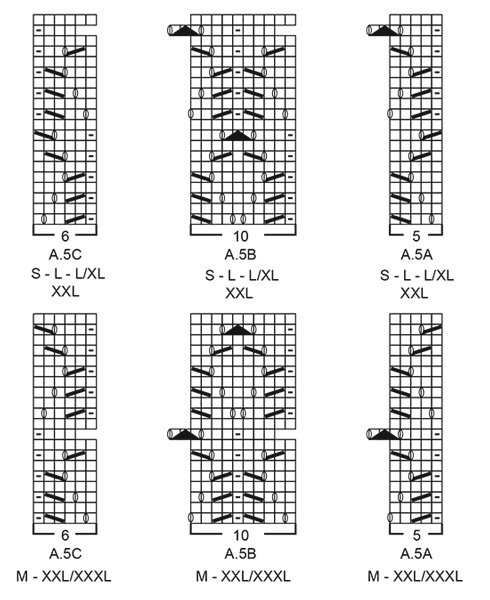
|
|||||||||||||||||||
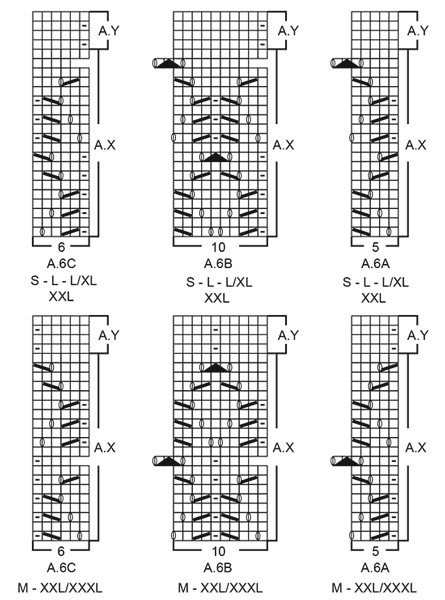
|
|||||||||||||||||||
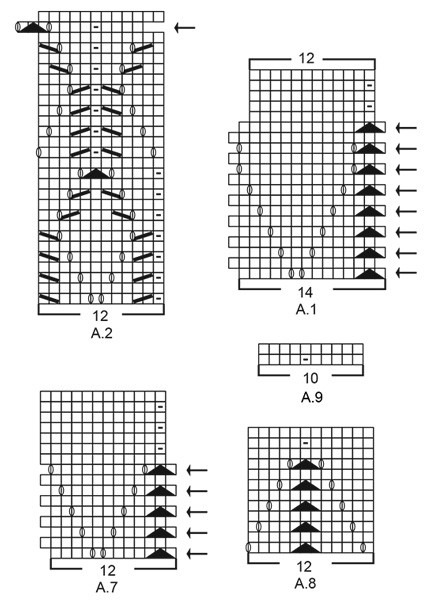
|
|||||||||||||||||||

|
|||||||||||||||||||
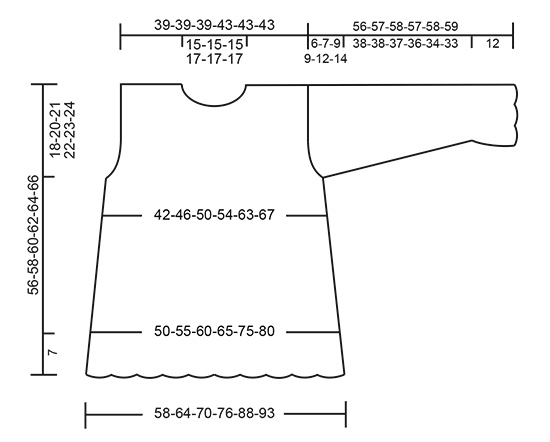
|
|||||||||||||||||||
|
Have you made this or any other of our designs? Tag your pictures in social media with #dropsdesign so we can see them! Do you need help with this pattern?You'll find tutorial videos, a Comments/Questions area and more by visiting the pattern on garnstudio.com. © 1982-2024 DROPS Design A/S. We reserve all rights. This document, including all its sub-sections, has copyrights. Read more about what you can do with our patterns at the bottom of each pattern on our site. |
|||||||||||||||||||







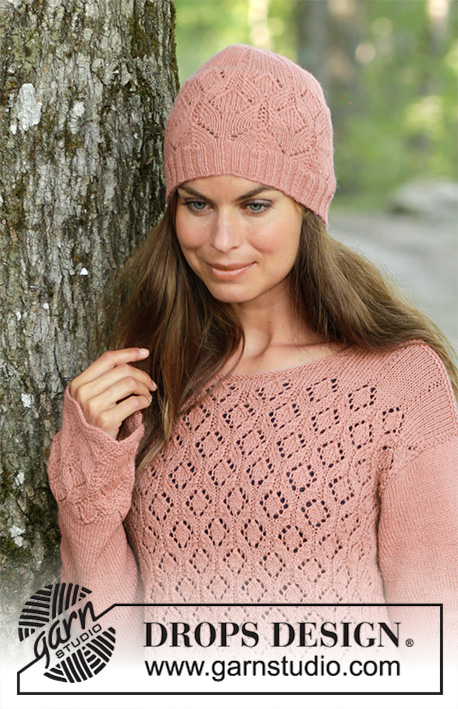


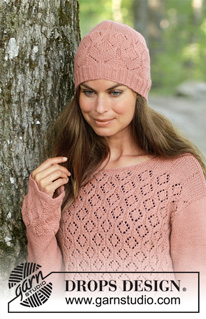


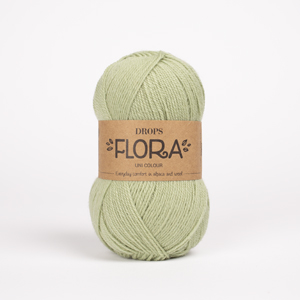
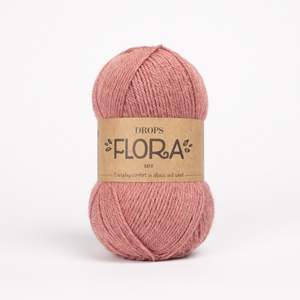














































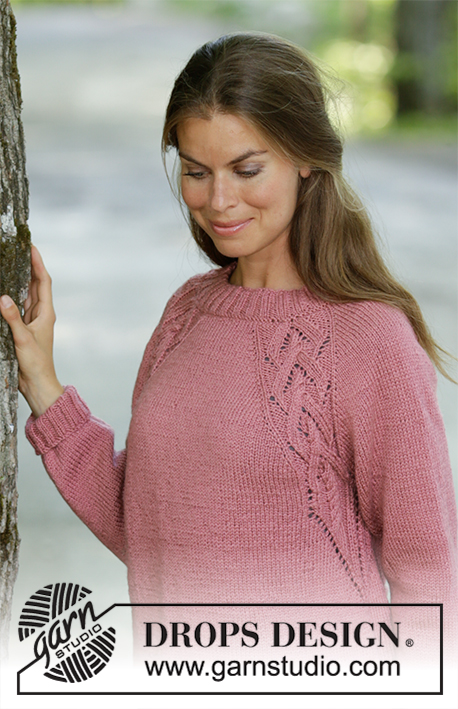
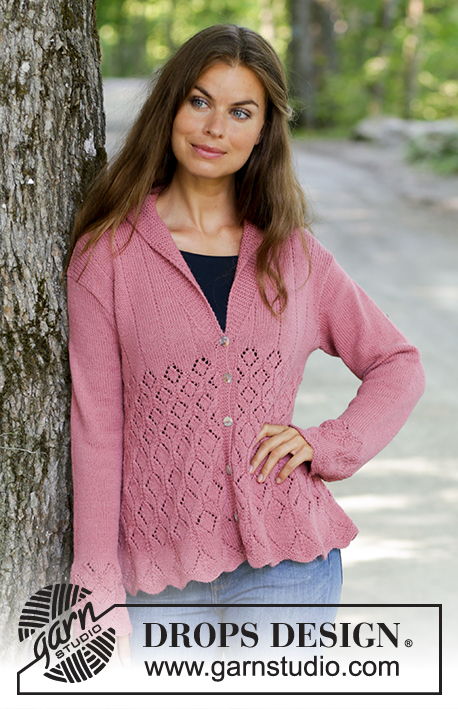






Comments / Questions (31)
Hallo, Ik vind dit een geweldig patroon. Maar ik heb er zo'n hekel aan om rond te breien. Ik doe liever op en neer omdat met rondbreien mijn werk vaak scheef wordt. Kan ik dit patroon door de helft delen en dan kantsteken toevoegen,of kom ik dan met de telpatronen in de knoei? Met vriendelijke groet, Nelleke
24.11.2020 - 14:15DROPS Design answered:
Dag Nel,
Dan kom je waarschijnlijk niet uit met het telpatroon, want dit loopt door in de zijnaad. Voor het aanpassen van patronen om ze met rechte naalden te kunnen breien, hebben we een instructie geschreven Deze kun je hier vinden. Kijk maar even of je hier wat aan hebt en in hoeverre je het ajourpatroon aan wilt passen, zodat je hem met rechte naalden kunt breien.
30.11.2020 - 20:53Bij het armsgat...kant je dan de tricot steken af en als die op zijn de patroonsteken, of kant je af en brei je daarna telkens dezelfde hoeveelheid (15) tricotsteken, waarna je verder gaat in patroon? Groet, Agnes
11.10.2020 - 22:35DROPS Design answered:
Dag Agnes,
Bij het armsgat kant je de aangegeven hoeveelheid steken af en je breit verder in patroon, je hoeft geen extra tricotsteken o.i.d. te breien, probeer gewoon het patroon zo ver mogelijk door te breien. Het patroon wordt dus afgebroken waar de mouw komt.
18.11.2020 - 22:38Leider lässt sich die Anleitung nicht kompett ausdrucken. Ich erhalte nur die 2 erste Seiten? LG Conny
18.12.2019 - 10:34DROPS Design answered:
Liebe Conny, wir könnten die komplette Anleitung als Test drucken, prüfen Sie mal die Druckereinstellungen, alle Seiten sollten ausgedruckt werden. Viel Spaß beim stricken!
18.12.2019 - 12:14I diagrammen över mönstret måste det vara fel, jag har jämfört med andra språk. Symbolen "-" är beskriven som avig maska på avig sida, men det borde bara avig maska på rät sida.
29.08.2019 - 16:02DROPS Design answered:
Hej. Tack för info, det hade blivit fel i den svenska översättningen. Detta är nu rättat. Mvh DROPS Design
30.08.2019 - 10:35J’ai terminé le col et je l’ai rabattu souplement. Tout est beau sauf au niveau du dos ou j’ai rabattu les mailles centrales du dos. Le col roule vers l’extérieur du chandail. Est-ce que j’aurais du les mettre en attente comme pour le devant ou j’ai trop relevé de mailles à ce niveau ? Merci de m’aider
20.08.2019 - 16:47DROPS Design answered:
Bonjour Mme Hébert, la première idée qui me vient est que vous avez peut-être rabattu ces mailles là trop souplement, mais il vaudrait mieux montrer votre ouvrage, même en photo, à votre magasin DROPS, il pourra plus facilement vous conseiller. Bon tricot!
21.08.2019 - 08:11Comment mesurer le tour de tête pour pouvoir choisir la bonne grandeur du bonnet ?
18.05.2019 - 15:08DROPS Design answered:
Bonjour Mme Hébert, mesurez le tour de tête au niveau du front (en gardant le mètre ruban bien droit). Le bonnet sera légèrement plus court en circonférence pour bien s'adapter à la tête et à la taille indiquée. Bon tricot!
20.05.2019 - 10:21Im Diagramm ist das Maß von 56 cm bis zum Beginn der Armausschnitte angegeben. In der Anleitung Seite 3 steht Armausschnitte: GLEICHZEITIG bei einer Länge von 38 cm für die Armauschnitte ... Wie ist das zu verstehen? Wann wird mit den Armausschnitte begonnen? Ich hoffe auf eine Antwort. Mit freundlichen Grüßen Petra
18.03.2019 - 18:51DROPS Design answered:
Liebe Petra, die Maschen für die Armausschnitte werden bei 38 cm abgekettet, dann stricken Sie jedes Teil separat bis 56 cm (= 18 cm Armausschnitt), so haben Sie: 38 cm + 18 cm = 56 cm gesamte Höhe. Viel Spaß beim stricken!
19.03.2019 - 10:17Hallo, Ihr solltet erwähnen, dass sich der Rapport ändert beim Wechsel von A1 auf A2 (genauso wie beim Wechsel von A7 auf A3). Die Linie mit den linken Maschen muss fortgesetzt werden, also muss A2 in der Mitte von A1 anfangen. Habe ich leider zu spät gemerkt, sieht aber auch gut aus, wenn man den Rapport nicht ändert, dann wird es eher ein Blattmuster am Übergang :-) Grüße, Christine
18.03.2019 - 09:40DROPS Design answered:
Liebe ChrisPJ, danke für den Hinweis, unser Designteam wird das mal schauen. Viel Spaß beim stricken!
18.03.2019 - 11:42På mitt mönster finns det inget.
06.12.2018 - 11:08DROPS Design answered:
Hei Cajsa. Ser du de andre diagrammene? gjelder dette uansett hvaslags enhet du bruker? (mobil, nettbrett, pc). Vi har dobbelsjekket dette hos oss, og alle diagrammene skal være synlige. Du kan eventuelt prøve å se på den norske eller danske oppskriften og se om du ser det der. God fornøyelse
06.12.2018 - 11:35Var är mönster A4??? Hittar inget sånt...
06.12.2018 - 10:00DROPS Design answered:
Hei Cajsa. A.4 ligger sammen med de andre diagrammene enderst på siden: Det ligger under A.6, til venstre for A.3 og over A.12. God fornøyesle
06.12.2018 - 11:04